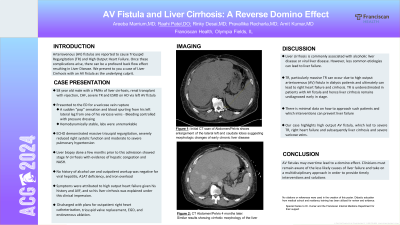Tuesday Poster Session
Category: Liver
P4703 - AV Fistulas and Liver Cirrhosis: A Reverse Domino Effect
Tuesday, October 29, 2024
10:30 AM - 4:00 PM ET
Location: Exhibit Hall E

Has Audio

Raahi Patel, DO
Franciscan Health Olympia Fields
Chicago, IL
Presenting Author(s)
Areeba Marrium, MD1, Raahi Patel, DO2, Rinky Desai, MD1, Pravallika Recharla, MD1, Amit Kumar, MD1
1Franciscan Health Olympia Fields, Chicago, IL; 2Franciscan Health Olympia Fields, Olympia Fields, IL
Introduction: Arteriovenous (AV) fistulas are reported to cause tricuspid Regurgitation (TR) and high Output Heart Failure. Once these complications arise, there can be a profound back flow effect resulting in liver disease. We present to you a case of liver cirrhosis with an AV fistula as the underlying culprit.
Case Description/Methods: Our patient is a 58 year old male with a PMHx of liver cirrhosis, renal transplant with rejection, CHF, severe TR and ESRD on HD via left AV fistula. He presented to the ED for a varicose vein rupture. He stated he had a sudden “pop” sensation and blood spurting from his left lateral leg from one of his varicose veins. He was hemodynamically stable, labs were unremarkable. The bleeding was stopped with a pressure dressing. Cardiology and Nephrology were consulted on his case. An echo was ordered that showed massive tricuspid regurgitation, severely reduced right systolic function and moderate to severe pulmonary hypertension. Notably, he had a liver biopsy done a few months prior to this admission that showed stage IV cirrhosis with evidence of hepatic congestions and NASH. He has not had any history of alcohol use and outpatient workup was negative for viral hepatitis, A1AT deficiency, and iron overload. The patient’s symptoms were attributed to high output heart failure given his history and AVF, and his liver cirrhosis was explained under this clinical impression. The patient was discharged with plans for outpatient right heart cath, tricuspid valve replacement, EGD, and endovenous ablation.
Discussion: Liver cirrhosis is commonly associated with alcoholic liver disease or viral liver disease. However, less common etiologies can lead to liver failure. TR, particularly massive TR can occur due to high output arteriovenous (AV) fistula in dialysis patients and ultimately can lead to right heart failure and cirrhosis. TR is underestimated in patients with AV fistula and hence liver cirrhosis remains undiagnosed early in stage. There is less data on how to approach such patients and which interventions can prevent liver failure. Our case highlights high output AV fistula caused severe TR, right heart failure and subsequently liver cirrhosis and severe varicose veins.
CONCLUSION: AV fistulas may overtime lead to a domino effect. Clinicians must remain aware of the less likely causes of liver failure and take on a multi-disciplinary approach in order to provide timely interventions and solutions.
Disclosures:
Areeba Marrium, MD1, Raahi Patel, DO2, Rinky Desai, MD1, Pravallika Recharla, MD1, Amit Kumar, MD1. P4703 - AV Fistulas and Liver Cirrhosis: A Reverse Domino Effect, ACG 2024 Annual Scientific Meeting Abstracts. Philadelphia, PA: American College of Gastroenterology.
1Franciscan Health Olympia Fields, Chicago, IL; 2Franciscan Health Olympia Fields, Olympia Fields, IL
Introduction: Arteriovenous (AV) fistulas are reported to cause tricuspid Regurgitation (TR) and high Output Heart Failure. Once these complications arise, there can be a profound back flow effect resulting in liver disease. We present to you a case of liver cirrhosis with an AV fistula as the underlying culprit.
Case Description/Methods: Our patient is a 58 year old male with a PMHx of liver cirrhosis, renal transplant with rejection, CHF, severe TR and ESRD on HD via left AV fistula. He presented to the ED for a varicose vein rupture. He stated he had a sudden “pop” sensation and blood spurting from his left lateral leg from one of his varicose veins. He was hemodynamically stable, labs were unremarkable. The bleeding was stopped with a pressure dressing. Cardiology and Nephrology were consulted on his case. An echo was ordered that showed massive tricuspid regurgitation, severely reduced right systolic function and moderate to severe pulmonary hypertension. Notably, he had a liver biopsy done a few months prior to this admission that showed stage IV cirrhosis with evidence of hepatic congestions and NASH. He has not had any history of alcohol use and outpatient workup was negative for viral hepatitis, A1AT deficiency, and iron overload. The patient’s symptoms were attributed to high output heart failure given his history and AVF, and his liver cirrhosis was explained under this clinical impression. The patient was discharged with plans for outpatient right heart cath, tricuspid valve replacement, EGD, and endovenous ablation.
Discussion: Liver cirrhosis is commonly associated with alcoholic liver disease or viral liver disease. However, less common etiologies can lead to liver failure. TR, particularly massive TR can occur due to high output arteriovenous (AV) fistula in dialysis patients and ultimately can lead to right heart failure and cirrhosis. TR is underestimated in patients with AV fistula and hence liver cirrhosis remains undiagnosed early in stage. There is less data on how to approach such patients and which interventions can prevent liver failure. Our case highlights high output AV fistula caused severe TR, right heart failure and subsequently liver cirrhosis and severe varicose veins.
CONCLUSION: AV fistulas may overtime lead to a domino effect. Clinicians must remain aware of the less likely causes of liver failure and take on a multi-disciplinary approach in order to provide timely interventions and solutions.
Disclosures:
Areeba Marrium indicated no relevant financial relationships.
Raahi Patel indicated no relevant financial relationships.
Rinky Desai indicated no relevant financial relationships.
Pravallika Recharla indicated no relevant financial relationships.
Amit Kumar indicated no relevant financial relationships.
Areeba Marrium, MD1, Raahi Patel, DO2, Rinky Desai, MD1, Pravallika Recharla, MD1, Amit Kumar, MD1. P4703 - AV Fistulas and Liver Cirrhosis: A Reverse Domino Effect, ACG 2024 Annual Scientific Meeting Abstracts. Philadelphia, PA: American College of Gastroenterology.
